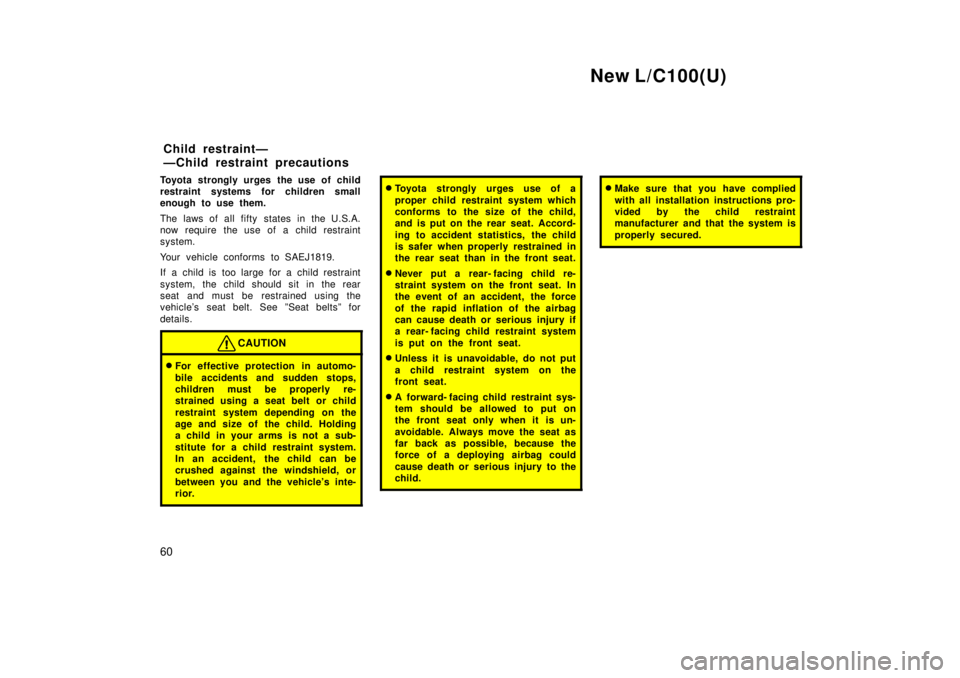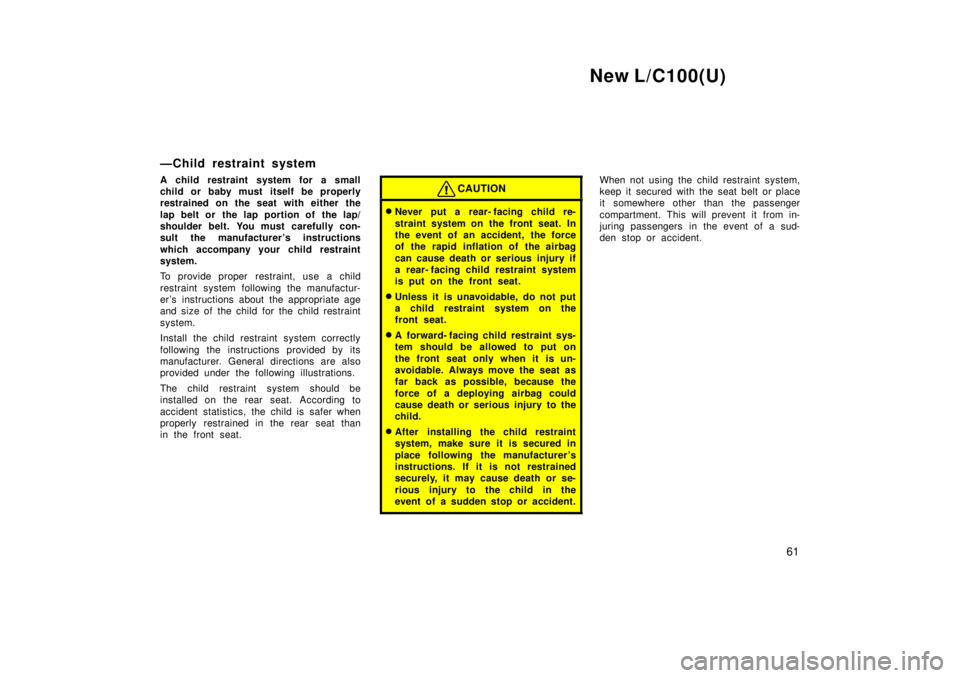Page 42 of 202

New L/C100(U)
50
To connect the extender to the seat
belt, insert the tab into the seat belt
buckle so that the ºPRESSº signs on
the buckle- release buttons of the ex-
tender and the seat belt are both facing
outward as shown.
You will hear a click when the tab locks
into the buckle.
When releasing the seat belt, press on
the buckle- release button on the extender,
not on the seat belt. This helps prevent
damage to the vehicle interior and extend-
er itself.
When not in use, remove the extender
and store in the vehicle for future use.
CAUTION
� After inserting the tab, make sure
the tab and buckle are locked and
that the lap and shoulder portions
of the belt is not twisted.
� Do not insert coins, clips, etc. in
the buckle as this may prevent you
from properly latching the tab and
buckle.
� If the seat belt does not function
normally, immediately contact your
Toyota dealer. Do not use the seat
until the seat belt is fixed. It cannot
protect an adult occupant or your
child from injury.
ÐFront seat belt pretensioners
The driver and front passenger 's seat
belt pretensioners are designed to be
activated in response to a severe fron-
tal impact.
When the airbag sensor detects the shock
of a severe frontal impact, the front seat
belt is quickly drawn back in by the re-
tractor so that the belt snugly restrains
the front seat occupants.
The seat belt pretensioners are activated
even with no passenger in the front seat.
Page 48 of 202

New L/C100(U)
56
A crash severe enough to inflate the air-
bags may break the windshield as the
vehicle buckles. In vehicles with a pas-
senger airbag the windshield may also be
damaged by absorbing some of the force
of the inflating airbag.
CAUTION
�
The SRS airbag system is designed
only as a supplement to the prima-
ry protection of the driver side and
front passenger side seat belt sys-
tems. The front seat occupants can
be killed or seriously injured by an
inflating airbag if they do not wear
the available seat belts. During sud-
den braking just before a collision,
an unrestrained driver or front pas-
senger can move forward into direct
contact with or close proximity to
the airbag which may then deploy
during the collision. To obtain maxi-
mum protection in an accident, the
driver and all passengers in the ve-
hicle must wear their seat belts.
Wearing a seat belt during an acci-
dent reduces the chances of death
or serious injuries or being thrown
out of the vehicle. For instructions
and precautions concerning the seat
belt system, see ºSeat beltsº in this
chapter.
�Improperly seated and/or restrained
infants and children can be killed
or seriously injured by a deploying
airbag. An infant or child who is
too small to use a seat belt should
be properly secured using a child
restraint system. Toyota strongly
recommends that all infants and
children be placed in the rear seat
of the vehicle and properly re-
strained. The rear seat is the safest
for infants and children. For in-
structions concerning the installa-
tion of a child restraint system, see
ºChild restraintº in this chapter.
Page 49 of 202
New L/C100(U)57
�Never put a rear- facing child re-
straint system on the front seat be-
cause the force of the rapid infla-
tion of the passenger airbag can
cause death or serious injury to the
child.
Move seat fully back
�A forward- facing child restraint sys-
tem should be allowed to put on
the front seat only when it is un-
avoidable. Always move the seat as
far back as possible, because the
force of a deploying airbag could
cause death or serious injury to the
child.
For instructions concerning the
installation of a child restraint sys-
tem, see ºChild restraintº in this
chapter.�Do not sit on the edge of the seat
or lean over the dashboard when
the vehicle is in use. The airbags
inflate with considerable speed and
force; you may be killed or serious-
ly injured. Sit up straight and well
back in the seat, and always use
your seat belt.
Page 50 of 202

New L/C100(U)
58
� Do not allow a child to stand up,
or to kneel on the front passenger
seat. The airbag inflates with con-
siderable speed and force; the child
may be killed or seriously injured.
� Do not hold a child on your lap or
in your arms. Use a child restraint
system in the rear seat. For instruc-
tions concerning the installation of
a child restraint system, see ºChild
restraintº in this chapter.�Do not put objects or your pets on
or in front of the dashboard or
steering wheel pad that houses the
airbag system. They might restrict
inflation or cause death or serious
injury as they are projected rear-
ward by the force of deploying air-
bags. Likewise, the driver and front
passenger should not hold things in
their arms or on their knees.
�Do not modify or remove any wir-
ing. Do not modify, remove, strike
or open any components such as
the steering wheel pad, steering
wheel, column cover, front passen-
ger airbag cover, front passenger
airbag or airbag sensor assembly.
Doing any of these may cause sud-
den SRS airbag inflation or disable
the system, which could result in
death or serious injury.
Failure to follow these instructions
can result in death or serious inju-
ries.
Page 52 of 202

New L/C100(U)
60
Toyota strongly urges the use of child
restraint systems for children small
enough to use them.
The laws of all fifty states in the U.S.A.
now require the use of a child restraint
system.
Your vehicle conforms to SAEJ1819.
If a child is too large for a child restraint
system, the child s
hould sit in the rear
seat and must be restrained using the
vehicle's seat belt. See ºSeat beltsº for
details.
CAUTION
� For effective protection in automo-
bile accidents and sudden stops,
children must be properly re-
strained using a seat belt or child
restraint system depending on the
age and size of the child. Holding
a child in your arms is not a sub-
stitute for a child restraint system.
In an accident, the child can be
crushed against the windshield, or
between you and the vehicle's inte-
rior.
�Toyota strongly urges use of a
proper child restraint system which
conforms to the size of the child,
and is put on the rear seat. Accord-
ing to accident statistics, the child
is safer when properly restrained in
the rear seat than in the front seat.
� Never put a rear- facing child re-
straint system on the front seat. In
the event of an accident, the force
of the rapid inflation of the airbag
can cause death or serious injury if
a rear- facing child restraint system
is put on the front seat.
� Unless it is unavoidable, do not put
a child restraint system on the
front seat.
� A forward- facing child restraint sys-
tem should be allowed to put on
the front seat only when it is un-
avoidable. Always move the seat as
far back as possible, because the
force of a deploying airbag could
cause death or serious injury to the
child.�Make sure that you have complied
with all installation instructions pro-
vided by the child restraint
manufacturer and that the system is
properly secured.
Child restraintÐ
ÐChild restraint precautions
Page 53 of 202

New L/C100(U)61
ÐChild restraint system
A child restraint system for a small
child or baby must itself be properly
restrained on the seat with either the
lap belt or the lap portion of the lap/
shoulder belt. You must carefully con-
sult the manufacturer 's instructions
which accompany your child restraint
system.
To provide proper restraint, use a child
restraint system following the manufactur-
er 's instructions about the appropriate age
and size of the child for the child restraint
system.
Install the child restraint system correctly
following the instructions provided by its
manufacturer. General directions are also
provided under the following illustrations.
The child restraint system should be
installed on the rear seat. According to
accident statistics, the child is safer when
properly restrained in the rear seat than
in the front seat.
CAUTION
�
Never put a rear- facing child re-
straint system on the front seat. In
the event of an accident, the force
of the rapid inflation of the airbag
can cause death or serious injury if
a rear- facing child restraint system
is put on the front seat.
� Unless it is unavoidable, do not put
a child restraint system on the
front seat.
� A forward- facing child restraint sys-
tem should be allowed to put on
the front seat only when it is un-
avoidable. Always move the seat as
far back as possible, because the
force of a deploying airbag could
cause death or serious injury to the
child.
� After installing the child restraint
system, make sure it is secured in
place following the manufacturer 's
instructions. If it is not restrained
securely, it may cause death or se-
rious injury to the child in the
event of a sudden stop or accident.
When not using the child restraint system,
keep it secured with the seat belt or place
it somewhere other than the passenger
compartment. This will prevent it from in-
juring passengers in the event of a sud-
den stop or accident.
Page 54 of 202
New L/C100(U)
62
Child restraint systems are classified into
the following 3 types depending on the
child's age and size.
(A) Infant seat
(B) Convertible seat
(C) Booster seat
Install the child restraint system following
the instructions provided by its manufac-
turer.
(A) Infant seat
(B) Convertible seat
(C) Booster seat
ÐTypes of child restraint
system
Page 55 of 202
New L/C100(U)63
(A) INFANT SEAT INSTALLATION
An infant seat is used in rear- facing
position only.CAUTION
Do not put a rear- facing child re-
straint system on the third seat if it
interferes with the lock mechanism of
the second seats. This may cause se-
vere injury to the child and passen-
gers sitting in the second seats in
case of sudden braking or a collision.
1. Run the center lap belt through or
around the infant seat following the
instructions provided by its manufactur-
er and insert the tab into the buckle
taking care not to twist the lap belt.
ÐInstallation with 2- point
type seat belt